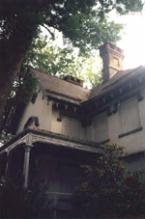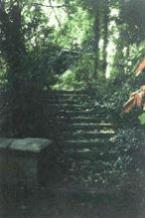|
Each
September, the Camp
Curtin Historical Society conducts
Civil War themed tours of the historic Harrisburg Cemetery. In 2002,
the society first presented a special tour, led by Afrolumens Project historian
George
F. Nagle, that focused
on the ways in which some of the persons buried in Harrisburg Cemetery
interacted with the local African American community. Among
other topics, the tour examined slave holding, the Underground Railroad,
racism, and the role of African Americans in the Civil War and post-war
Harrisburg. On this, and subsequent pages, are highlights of that
special tour.
|
Introduction and tour index
 arrisburg Cemetery is situated on a bluff overlooking the
downtown portion of the city. From the western boundary of the cemetery,
visitors are treated to a magnificent sweeping view of the Capitol Complex and
the city skyline. Mature trees and intricate landscaping hide the
cemetery's sun bleached monuments, mysterious mausoleums and stately obelisks
from return view, however. You can look out, but it seems that you
can't look in. Although surrounded on three sides by major roadways that
carry thousands of persons daily past its serene landscape, few people know of
the beauty that exists behind the metal fences. To discover this gem
hidden within the city's Allison Hill neighborhood, you have to enter through
the large iron-gated entrance at Thirteenth and Liberty Streets. arrisburg Cemetery is situated on a bluff overlooking the
downtown portion of the city. From the western boundary of the cemetery,
visitors are treated to a magnificent sweeping view of the Capitol Complex and
the city skyline. Mature trees and intricate landscaping hide the
cemetery's sun bleached monuments, mysterious mausoleums and stately obelisks
from return view, however. You can look out, but it seems that you
can't look in. Although surrounded on three sides by major roadways that
carry thousands of persons daily past its serene landscape, few people know of
the beauty that exists behind the metal fences. To discover this gem
hidden within the city's Allison Hill neighborhood, you have to enter through
the large iron-gated entrance at Thirteenth and Liberty Streets.
 Once inside, visitors will find a well-maintained historic
cemetery. Harrisburg Cemetery, established in 1845, is a
35-acre landscaped treasure of historic importance, not only because it is the
oldest and largest cemetery within the city, but also because it is the final
resting place of many persons who played important roles in local, state and
national affairs. From the Gothic
Revival Caretaker’s House, designed in the style popularized by nationally renowned architect A. J.
Downing, to the impressive and beautiful tombs of governors, industrialists,
congressmen, soldiers, suffragettes, artists and many more, visitors can explore
beautiful winding pathways and grassy lanes in a leisurely walk. Once inside, visitors will find a well-maintained historic
cemetery. Harrisburg Cemetery, established in 1845, is a
35-acre landscaped treasure of historic importance, not only because it is the
oldest and largest cemetery within the city, but also because it is the final
resting place of many persons who played important roles in local, state and
national affairs. From the Gothic
Revival Caretaker’s House, designed in the style popularized by nationally renowned architect A. J.
Downing, to the impressive and beautiful tombs of governors, industrialists,
congressmen, soldiers, suffragettes, artists and many more, visitors can explore
beautiful winding pathways and grassy lanes in a leisurely walk.
The Harrisburg Cemetery has few African
Americans buried on its grounds, due in part to a tradition of segregated
burial that preceded its establishment, and due also to a policy of exclusion instituted in the early decades of the twentieth century. Those exclusions may make the notion of an
African American history tour through the grounds of this cemetery seem out of
place, but Afrolumens Project historians have turned up a wealth of information on many of
the cemetery’s “residents” who were intimately involved with Harrisburg’s
African American community. This online tour will visit the gravesites of slaveholders, anti-slavery activists, Underground
Railroad stationmasters, political and moral reformers, progressive
industrialists and many more who had a defining impact on the lives of state
and local African Americans.
To begin, and to follow the tour, simply click the "Next" button at the
bottom of this and each page. Or you can visit graves selectively by
following the links to each page in the index below.
Tour index
Richard J. Haldeman
(1831-1885) Racist Politics in a Volatile Age
Thomas Elder (1767-1853)
Lawyer, Banker, Slaveholder
Mordecai McKinney (1796-1867) "A Friend
of the Oppressed and Downtrodden"
Charles Coatesworth
Rawn (1802-1865) "this Nation will yet weep"
Andrew M. Bradley
(1906-1983) Black Statesman and Civic Leader
Simon Cameron (1799-1889) The Emancipation Question
"For the
Burial of Such White People" A
Restricted Cemetery
|
